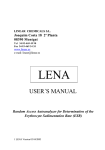Download SERVIS Drawer 17inch [FD-1100AT] User`s Manual
Transcript
Preliminary Ver.0.50 SERVISTM Drawer 17inch [FD-1100MT] NC14010-B452/xx User's Manual FCC WARNING: Changes or modifications not expressly approved by the party responsible for compliance could void the user's authority to operate the equipment. This equipment has been tested and found to comply with the limits for a Class A digital device, pursuant to Part 15 of the FCC Rules. These limits are designed to provide reasonable protection against harmful interference when the equipment is operated in a commercial environment. This equipment generates, uses, and can radiate radio frequency energy and, if not installed and used in accordance with the instruction manual, may cause harmful interference to radio communications. Operation of this equipment in a residential area is likely to cause harmful interference in which case the user will be required to correct the interference at his own expense. This device has been classified as a Class A product by VCCI (Voluntary Control Council for Interference by Information Technology Equipment). If you use this product in a domestic environment, it may cause radio interference, in which case the user may be held responsible for the cost of any required corrective action.VCCI-A All Rights Reserved, Copyright© FUJITSU LIMITED 2005 Contents 1. Preface ................................................................................... 1 1.1 Conventions ......................................................................................................................... 1 1.2 Packing List .......................................................................................................................... 1 2. Important Notices ................................................................... 2 2.1 Safety ................................................................................................................................... 3 2.2 Moving Console Drawer ....................................................................................................... 4 2.3 Disposal................................................................................................................................ 4 2.4 Safety Precautions and Limited Warranty Information.......................................................... 4 3. Installation .............................................................................. 6 3.1 Installing the Console Drawer (procedure for tapped guide rails) ......................................... 6 3.2 Installation Procedure........................................................................................................... 6 3.3 Installing the 4-port KVM Switch........................................................................................... 9 4. Connecting and Removing Cables........................................11 4.1 Connecting the Cables ........................................................................................................11 4.2 Removing Cables ................................................................................................................11 5. Connecting to Multiple Servers (with a 4-port KVM Switch installed in the back of the Console Drawer.) ............................ 12 6. Operation.............................................................................. 13 6.1 Operating the Console Drawer ........................................................................................... 13 6.2 Adjusting the Monitor .......................................................................................................... 15 6.2 Adjusting the Monitor .......................................................................................................... 16 6.3 Basic Adjustment Procedure .............................................................................................. 17 6.4 Main Menu Items ................................................................................................................ 18 6.5 Resolutions and Refresh Rates .......................................................................................... 19 6.6 Caution: LCD display.......................................................................................................... 19 6.7 Keyboard Operation ........................................................................................................... 20 6.8 Pointing Device Operation.................................................................................................. 22 6.9 Hot-key and Reset Buttons................................................................................................. 23 6.10 Using a 4-port KVM Switch............................................................................................... 23 6.11 Stowing Console Drawer .................................................................................................. 24 7. Cleaning the Console Drawer .............................................. 25 8. Technical Specifications ....................................................... 27 9. Optional Accessories (Sold separately) ............................... 29 9.1 Optional Cables .................................................................................................................. 29 9.2 Optional Guide rails ............................................................................................................ 29 10. Troubleshooting.................................................................. 30 10.1 No image displayed on monitor ........................................................................................ 30 10.2 Monitor display is strange................................................................................................. 30 10.3 Monitor cannot be adjusted .............................................................................................. 31 10.4 Other Irregularities in Monitor Display .............................................................................. 31 10.5 Others............................................................................................................................... 32 1. Preface Congratulations on your purchase of the server rack mountable Console Drawer (SERVIS™ DRAWER 17 inch). (hereinafter called "Console Drawer", "this product" or "this device") Using this product will greatly improve the efficiency and functionality of the workspace around your racks. Space that was used in previous layouts can now be used more freely due to our compact sliding module design. The 17-inch TFT monitor has a resolution of 1280 x 1024 dots with 16,770,000 colors. Also, it is equipped with a keyboard and 3-button pointing device. 1.1 Conventions Symbols and terminology that are used in this manual are described below. CAUTION This symbol indicates the possibility of physical damage (such as damage to the Console Drawer) or physical injury, which may result if the Console Drawer is operated incorrectly by ignoring this symbol. This logo indicates supplemental information, comments or hints. Text that is preceded by a sequence of numbers (1, 2, etc.) means that the operations must be performed in the indicated order. References to important chapter titles and terminology are in brackets [ ]. 1.2 Packing List Make sure that the items in the following list were included in the shipping package. Console Drawer x 1 4 port KVM Switch Screws x 4 (in a nylon bad tapped to the Console Drawer) DC Cable x 1 (in a nylon bag taped to the Console Drawer) Operation Manual (this manual) x 1 We recommend keeping the box and packing material in which the Console Drawer was purchased. They may be required when moving it to another location. If something is missing from the package, contact your place of purchase or a Fujitsu sales person. Similarly, as they will be needed when the 4-port KVM switch is installed, the 4-port KVM switch screws and DC cable should be left taped to the Console Drawer. CAUTION Please note the safety information in [Important Notices]. 1. Unpack the Console Drawer and check that it has not been damaged in transit. 2. Remove the rubber stabilizer from the front left side of the Console Drawer. The rubber stabilizer is inserted to prevent the Console Drawer from sliding when installing or moving it. Be sure to keep it after finishing the installation for when it needs to be used again. Latch Lever Console Drawer Rubber Stabilizer Rubber stabilizer removal 2. Important Notices 2 This chapter contains cautions that must be taken when operating the Console Drawer and information related to safety. Carefully read this chapter to use the Console Drawer correctly. 2.1 Safety CAUTION Precautions This device conforms to the safety regulations related to information processing equipment such as electronic office machines that are used in an office environment. If you have any questions please contact your place of purchase or a Fujitsu sales person. To prevent extreme bumping, shaking, vibration while moving the Console Drawer, please use the original shipping container or a similar box, in addition make sure if it fits well to the product for protection. During installation and before using the Console Drawer, carefully read [Installation] and the section about environmental conditions in [Technical Specifications] to use the Console Drawer correctly. Moving the Console Drawer from a cold environment to the installation location may cause condensation to occur. Before using the Console Drawer allow it to dry out completely and to reach the ambient temperature of the installation location. Make sure that the local power supply voltage is within the acceptable range of the Console Drawer. Make sure that the rated voltage meets the specifications of this device (Refer to [Technical Specifications] and the model plate on this device). The Console Drawer's power cable is specially certified. Do not connect it to anything other than a rack power outlet in order to avoid electric shocks and/or short circuits. Arrange the adequate area to have the plug quickly pulled out around the Console Drawer's power socket or the rack's power outlet . Lay all the cables so that they will not be damaged. Refer to the relevant sections in [Installation] when connecting and removing cables. Do not connect or remove any cables during thunderstorms. Do not allow foreign substances (such as necklaces or paperclips) or liquids inside the Console Drawer. In an emergency (such as: damage to the housing, parts or cables; or liquid or a foreign object has fallen into the Console Drawer) remove the power cable as soon as possible and contact your place of purchase or an authorized maintenance person. Do not disassemble or modify the Console Drawer for any purpose, which may cause electric shocks, or fire and so on. Only licensed engineers may repair the Console Drawer. Note that the corners of the open Console Drawer can be dangerous if bumped into. Always be careful when the Console Drawer is open. It is recommended that the Console Drawer be stowed away in the rack when it is not in use, or when other nearby servers or peripheral equipments are being used. Avoid using the keyboard when in poor health or for extended periods of time. Always hold the connector portion and do not jerk the cables when removing them. Avoid operating the Console Drawer with wet hands. Do not plug or unplug connectors with wet hands. Do not place such unnecessary items as cups on the top of the Console Drawer. Do not modify or repair the Console Drawer. Only licensed personnel may disassemble, remove or switch parts (such as power supply 3 units) that bear a warning mark (such as a lightning bolt mark). Only the resolutions and refresh rates specified in [Adjusting the Monitor] may be set. Using settings other than those noted may damage the monitor. Contact your place of purchase or a Fujitsu maintenance person if you have any questions. To prevent interference it is necessary to adequately isolate the data cables connected to peripheral equipment. To cut off the power supply, unplug the power cable from the rack power outlet. Follow the instructions in the appropriate section in [Operation] when cleaning the server. Keep this manual with the Console Drawer at all times. Do not use the Console Drawer as a stepladder or lean against it with it drawn out. Doing so may unbalance the rack, causing it to fall over. Some limited life components (such as the LCD, etc.) are included in this product. In cases of extended continuous use, the performance of these components is easily decreased. To avoid damage to this equipment or personal injury, return console drawer to its closed position when not in use. 2.2 Moving Console Drawer CAUTION When moving the Console Drawer to a different location, use the box in which it was purchased or a box that protects the product from bumping and shaking. Do not unpack the Console Drawer until the move has been completed. 2.3 Disposal CAUTION This device consists of metal, plastic, electronic parts and so on. Some electronic components, such as LCD monitor, include lead. When it is disposed of, follow exactly the relevant government regulations, instructions and so on. 2.4 Safety Precautions and Limited Warranty Information Fujitsu’s Products are not designed for use in medical or life support appliances, devices, or systems where malfunction of a Product can reasonably be expected to result in a personal injury. The Product is designed, developed and manufactured as contemplated for general use, including, general office use, personal use, household use, and ordinary industrial use, but is not for use for high risks or dangers that could reasonably be expected to result in personal injury, or other loss including without limitation, nuclear application, aircraft flight control, air traffic control, mass transport control, medical life support system, or missile launch control in weapon system (“High Safety Required Use”). You should not use this Product without securing sufficient safety required for such High Safety Required Use. Purchaser and its customers using or selling Products for use in such applications do so at their own risk and agree to fully indemnify Fujitsu for any damages resulting in such improper use or sale. Fujitsu Component Limited or its affiliates (“Fujitsu”) warrants all Product against defects in materials and workmanship for a limited period not to exceed one (1) year from the date of 4 delivery to Fujitsu authorized distributor or authorized system integrator (“Authorized Company”). Check with Fujitsu for such Authorized Company. Fujitsu’s liability under this warranty is limited, at Fujitsu’s sole discretion, to repairing, or replacing any component with new or like new components or parts, or replacing with a refurbished or alternative product, or issuing credit for the purchase price, if paid, for such Product that was defective at the time delivered to Purchaser, provided that Fujitsu will not be liable under this warranty unless: (i) Fujitsu is promptly notified in writing upon the discovery of defects by Purchaser; (ii) the defective unit is returned to Authorized Company, transportation charges prepaid by Purchaser; (iii) the defective unit is received for adjustment no later than one year following the date on which such Products were delivered by Fujitsu to Authorized Company; and (iv) Fujitsu’s examination of such units shall disclose, to its satisfaction, that such defects have not been caused by misuse, neglect, improper installation, repair, alteration, accident, improper storage or other action or inaction beyond reasonable practice for such Product. This warranty shall be administered and returned to the party from whom Purchaser purchased Product which is an Authorized Company. THE WARRANTY SET FORTH IN THIS SECTION IS IN LIEU OF, AND EXCLUDES, AND EACH PARTY HEREBY WAIVES, ANY OTHER REPRESENTATIONS, GUARANTEES AND WARRANTIES, EXPRESS, IMPLIED OR STATUTORY, INCLUDING, WITHOUT LIMITATION, ANY WARRANTY OF MERCHANTABILITY, OR FITNESS FOR A PARTICULAR PURPOSE. IN NO EVENT SHALL FUJITSU BE LIABLE TO PURCHASER FOR LOSS OF PROFITS, LOSS OF USE, COST OF SUBSTITUTE GOODS, OR CONSEQUENTIAL OR INCIDENTAL DAMAGES OF ANY KIND BASED UPON A CLAIM FOR BREACH OF WARRANTY OR OTHERWISE. FUJITSU'S WARRANTIES SHALL NOT BE ENLARGED, DIMINISHED, OR AFFECTED BY, AND NO OBLIGATION OR LIABILITY SHALL ARISE OR GROW OUT OF, SELLER'S RENDERING OF TECHNICAL ADVICE OR SERVICE IN CONNECTION WITH BUYER'S ORDER OR THE PRODUCTS FURNISHED HEREUNDER. 5 3. Installation CAUTION Please note the safety information in [Important Notices]. 3.1 Installing the Console Drawer (procedure for tapped guide rails) CAUTION Observe the specified environmental conditions when using the Console Drawer (See [Technical Specifications] for more information). Avoid dust, humidity and extreme temperatures. Installation may require two or more people in some situations. Be careful not to pinch your fingers or hands between the guide rails and the Console Drawer. 3.2 Installation Procedure 1. Insert the rear spacer studs of the guide rails into the holes in the rear rack pillars. Extend the guide rails to reach the inside of the front rack pillar. Fasten each guide rail with four screws, one into each of the top and bottom holes of both the front and rear spacers. (Install the left and right guide rails at the same height.) 2. Extend the guide rails to reach the inside of the front rack pillar. Fasten each guide rail in place with two screws, one into each of the top and bottom holes of the front spacer. (Attach the guide rails inside the front/rear rack pillar so that the guides face inwards.) 3. Install the left and right guide rails at the same height. Attach the guide rails so that they face inward and are open forward, ready to accept the Console Drawer. Attach the guide rails inside the front/rear rack pillar. See the "Installing the Guide Rails" diagram. 6 Rear Spacer Screws Guide Rail Front Spacer Rear Spacer Studs Guide Rear Spacer Screws Guide Rail Front Spacer Front Spacer Rear Rack Pillar Front Rack Pillar Installing the Guide Rails 7 4. Slide the Console Drawer into the front end of the guide rails. Be careful that the latch lever does not come loose. If the latch lever comes loose the Console Drawer may slip. If the Console Drawer does not slide easily into the guide rail or is too heavy, get one or more other people to help you lift and insert it. 5. Push the Console Drawer in until it stops, then fasten with two screws, one on each side of the front of the Console Drawer. Guide Rail Console Drawer Guides Guide Rail Latch Lever Screws Installing the Console Drawer 8 3.3 Installing the 4-port KVM Switch If you don't have a 4-port KVM Switch, please skip this section and go to the section for [Connecting and Removing the Cables]. Refer to [Connecting to Ports] for the connection in general. In details, refer to the original manual for the 4-port KVM switch. CAUTION To avoid electric shocks and/or short circuits, make sure that the power cable of this device is not plugged into the power outlets. Since this device may cause injury if it falls or tips over, be sure to work on a stable surface, such as on desk, table and so on. This device contains components that store and release high voltage electric charges. Make sure to work only after checking that it has been electrically discharged. Be careful not to cut yourself by sharp metal edges. To avoid damage, be careful of any objects falling (including metal objects, water, and liquids) into this device. Do not touch unnecessary place. To install 4 port KVM switch, refer to the manual of 4port KVM switch. Prepare screwdrivers (large and small) in advance. It is strongly recommended to install the 4-port KVM after removal of the Console Drawer from the rack. When removing Console Drawer, see [Installing the Console Drawer]. It requires the procedure in reverse order. 1. Take out four screws packed in nylon bag, which is taped on the open space area of the rear top panel. Make sure the rubber feet on the bottom of the 4-port KVM switch are removed . 2. Insert the 4-port KVM switch into the open space area of the rear top panel, making sure that the 4-port KVM switch’s connectors face out from the rear of the Console Drawer. 3. Fasten the 4-port KVM switch in place with the four screws, taken in step 1, over the rear top panel metal. 9 4-port KVM Switch Rubber Feet Rubber Feet Rear Panel Open Space Rear Plate Comp DC5V OUTPUT Screws Screws DC Cable Note) Make sure rubber feet to be removed in advance. Installing the 4-port KVM Switch 10 4. Connecting and Removing Cables 4.1 Connecting the Cables 1. Unplug all power cables, connected to related devices, from the power outlets. 2. Console Drawer I/F cable: 3 types subject to usage, One end for all cables are DVI CN. The other end: PS/2 I/F cable (D-SUB, 2 Mini-DIN:6-pin PS/2 CNs), USB I/F cable (D-SUB, USB CNs), Sun I/O I/F cable (D-Sub, 1 Mini-DIN:8-pin CN) - Connect the keyboard cable, mouse cable, and monitor cable to their respective ports. - Then, connect the DVI CN end to the console drawer. 3. Plug the AC power cable into the Console Drawer power socket. 4. Plug all the power cables into the power outlets. Connecting the cables to the Console Drawer: Case of PS/2 type I/F Cable usage Power Socket DVI Connector Console Drawer I/F Cable Power Cable Power Outlet D-SUB Connector Monitor Mouse (PS/2) Keyboard (PS/2) 4.2 Removing Cables Unplug power cables, connected to all the related devices, from the power outlets, and then remove each cable. 11 5. Connecting to Multiple Servers (with a 4-port KVM Switch installed in the back of the Console Drawer.) CAUTION See cautions given in [Connecting and Removing the Cables] when connecting and disconnecting ports. Also, cut the power of any affected equipment before you start working on it. Refer to the 4-port KVM Switch user's manual as well as this manual for more details. You can connect servers in accordance with the 4-port KVM specification. 1. PS/2 type of Console Drawer I/F cable is required. Connect each cable for keyboard, mouse and monitor from the Console Drawer, to the console port of 4-port KVM switch. 2. Use option cables to connect each server's keyboard, mouse and monitor port (VGA), accordingly, subject to the available configuration of the 4-port KVM Switch and each server port. In details, please refer to the 4-port KVM Switch manual. (The back of the Console Drawer) DVI Cable AC Adaptor for 4-Port KVM Switch or DC Cable (Attach DC cable to the back of the Console Drawer) Keyboard Mouse Monitor Special KVM-Server Cable Server 3 Server 4 Server 1 Server 2 Connecting the cables to a 4-port KVM Switch 12 6. Operation CAUTION CAUTION CAUTION Pull the Console Drawer slowly toward you until the slide rails lock. If the slide rails are not locked, the Console Drawer can move unexpectedly. If they do not lock, the weight of the Console Drawer or any person leaning on the Console Drawer may cause it to move suddenly, and it may cause injury or damage to the product Be careful not to pinch your fingers when pulling or pushing on the slide module or opening and closing the LCD, etc. Do not apply any significant force while the Console Drawer is pulled out, or while the Console Drawer is used, as there is a risk that the Console Drawer may be forced from the guide rails, damage the guide rails, or the rack may topple over, and cause personal injury or damage to the systems. Do not apply force to the monitor screen, and not scratch it with any objects, or not bring magnetic objects near the Console Drawer. They can cause failure or damage to these products. Note that the corners of the open Console Drawer can be dangerous if bumped into. Always Be careful of whatever operations are done close to the Console Drawer, while the Console Drawer is pulled out, because it is easy to be injured by hitting the Console Drawer accidentally. It is recommended that the Console Drawer be stowed away in the rack when it is not in use, or when other nearby servers or peripheral equipments are being used. 6.1 Operating the Console Drawer 1. Remove the rubber stabilizer when it is not already removed. 2. Push down the latch lever in left side of front end of the Console Drawer, and pull out the Console Drawer by the handle until the slide lock clicks into place. Before pulling it out, make sure that the two screws on the front of the Console Drawer are tightly fixed to the rack. 13 Guide Rail Cable Duct Slide Rail Console Drawer Latch Lever Handle Guide Rail Slide Rail LCD Lock Lock Spring Latch Lever 2 Rubber Stabilizer 1 Pulling out the slide module 14 3. Push up on the LCD lock behind the handle, and then grasp the handle and open the monitor by lifting it up. 4. Turn on the power by pushing the POWER button. Open the monitor completely. Handle LCD Lock Slide Rail Monitor(LCD) Monitor Power Button Hot-key Button Reset Button Guide Rail Keyboard Slide Rail Pointing Device LCD Lock Latch Lever Opening the LCD 15 6.2 Adjusting the Monitor The five buttons and one LED on the monitor are in order: Button Button Button Button Power Lamp Power Button Power Lamp: This lights blue when the power to the monitor is on, lights orange when the monitor is in energy-saving mode, and goes out when the power to the backlight is off. Power Button: Press this button to turn on the power to the monitor, or, if the power is already on, to cut the power to the monitor's backlight. MENU/ENTER Button: Press this to open the menu, select an item to be adjusted, and save an adjusted setting. + Button: Press this to select the right-hand item or increase the value. - Button: Press this to select the left-hand item or decrease the value. AUTO/EXIT Button: Press this to close the menu, cancel the selection of an item to be adjusted, cancel an adjusted setting, or perform automatic adjustment. It is possible to directly adjust the screen brightness by pressing the + button or - button when the menu is not displayed. It is possible to perform automatic adjustment (position and focus) by pressing the AUTO/EXIT button when the menu is not displayed. 16 6.3 Basic Adjustment Procedure The basic adjustment procedure is as follows: Some main menu items do not have associated sub-menus, in which case the adjustment screen appears when the item is selected. If the AUTO/EXIT button is pressed at this phase, the screen returns to the main menu and any adjustment to setting will not be saved. The screen brightness setting (BRIGHTNESS) can be adjusted using the + and - buttons without opening the main menu first. In this case the setting is saved as it is being adjusted. 17 6.4 Main Menu Items Symbol Item BRIGHTNESS Function Adjusts the screen brightness. CONTRAST Adjusts the screen contrast. COLOR Adjusts the screen color. Fixed values or individual color tones (red, green, blue) can be set. H POSITION Adjusts the display position (horizontal ). V POSITION Adjusts the display position (vertical). CLOCK Get rid of vertical striping (noise). FOCUS Get rid of horizontal noise and sharpens up blurred on-screen lettering. sRGB Switches the sRGB functions on/off. BLACK LEVEL Sets black color offset level at any value. GRADATION Changes the contrast curve to change half tone image expression TEXT MODE Sets the DOS screen resolution. Be sure to set 720 x 400 when using English DOS. LANGUAGE English,Deutsch,Italiano,Francais,Espanol INFORMATION Shows the currently set values for the screen resolution, vertical frequency, etc. (not all settings are shown) RECALL Reinstates the factory default values. READJUSTING Recalls all the factory default values. GEOMETRY Recalls the screen resolution, POSITION, CLOCK, and FOCUS default values. COLOR Recalls the BRIGHTNESS, CONTRAST, BLACK LEVEL, and COLOR default values. 18 6.5 Resolutions and Refresh Rates Resolution 640 x 400 640 x 480 720 x 400 800 x 600 1024 x 768 Horizontal frequency (kHz) 31.5 31.5 37.5 37.9 31.5 35.2 37.9 46.9 48.1 48.4 56.5 Vertical frequency (Hz) 70 60 75 72 70 56 60 75 72 60 70 60.0 75 64.0 60 80.0 75 61.9 66 71.8 76 71.4 67 1280 x 1024 1152 x 900 1280 x 1024 Mode VGA 400 LINE VGA Standard VESA Sun Composite 6.6 Caution: LCD display Following cases are not considered as a failure mode, and the device can be used normally: During or soon after power-on, O/S boot-up, power-off , or O/S shut-down, the display position may shift, blink, or otherwise be disturbed. Any native resolution can be displayed in 1280 x 1024, full screen mode, by scaling function. In this case, letters may be blurred and the thickness of thin lines might be uneven. This is because the full-screen display is made by digital interpolation of the low-res output, not by physical magnification. This is not a display failure, and the device can be used normally. Although there might be some dots or pixels that are always-off (black) or always-on (red, green or blue), this is a natural characteristic of LCDs and is within specification (it is not a defect), and you can use the device normally. 19 6.7 Keyboard Operation By making use of the Function ( Fn ) key, if is possible to obtain full keyboard functionality from even a reduced space keyboard. Fn key+ key combinations: The extra command keys that are enclosed in billets (e.g. Help ) around the perimeter of the keyboard may be accessed by pressing the associated key together with the Function key (e.g. Help = Fn + Esc ). The command keys that are not enclosed (e.g. <compose>) may be accessed by simply pressing the associated key (e.g. <compose> = <Windows menu key>). Fig US Keyboard Fig EU layout (ex: UK Keyboard) 20 Fig Japanese Keyboard Example of usage: Help = Fn + Esc 21 6.8 Pointing Device Operation Lightly touch or tap the touchpad surface to operate the pointing device. Moving the pointer: Lightly slide a finger over the touchpad surface in the direction you want the cursor to move. Single click: Lightly tap the touchpad surface once, or press the left button once. Double click: Lightly tap the touchpad surface twice, or press the left button twice in succession. Touchpad Left Button CAUTION Right Button 1.The pointing device is designed to be operated with one finger, and may not respond correctly if you try to operate it: (1) while wearing gloves; (2) with a pen, ballpoint pen or pencil etc; (3) with two or more fingers; (4) while something is resting on the touchpad surface. 2. Normal operation may become impossible if the touchpad surface is wet. This can occur when the humidity is high or the operator's hands are damp or sweaty. Thoroughly dry or wipe the touchpad surface before use. 3. Do not operate with pointed metal objects such as pens as it may damage the pointing device. 22 6.9 Hot-key and Reset Buttons Num Lock Caps Lock Scroll Lock Reset Hot-key Hot-key Button Reset Button Hot-key Button Outputs the [Ctrl] + [Alt] + [Shift] key Make/Break code. This will also be the Hot-key mode if a 4-port KVM switch is connected. Reset Button Resets the keyboard and pointing device. Also resets a 4-port KVM switch if one is connected. However, it will not reset any secondary (slave) 4-port KVM switches. CAUTION KVM Switch Reset is only valid with the following series: FS-1004, 1008, and 1016. 6.10 Using a 4-port KVM Switch The Console Drawer display parameters are the same regardless of video source, so the image position may shift around due to the different video settings in various servers. Generally, the resolution and refresh rate (vertical frequency) are the same for many servers, therefore one set of parameters, which support those server CRT controllers, are stored in the Console Drawer screen. If you change the Console Drawer display parameters to match the video output of one server, the video from all or some of the other servers may be negatively effected. To correct for multiple display issues, try the following: 1. Change the refresh rate of servers that do not display correctly to a different value. 2. Select the best compromise screen display and save the values. As multiple refresh rates for each resolution can usually be set, you can use various combinations for each of the servers to achieve optimum results. 23 6.11 Stowing Console Drawer The Console Drawer should be stowed away in the rack when the monitor and keyboard are not in use. Slide the Console Drawer in and out of the rack slowly. 1. Push the monitor power button to turn off the power to the monitor. 2. Hold the handle and slowly close the monitor. Be sure that the LCD lock engages. 3. Push the locking springs on both sides of the slide rail and slide the Console Drawer into the rack. Be sure the latch lever engages. CAUTION Be careful not to pinch your fingers in the guide rails, slide rails, or the Console Drawer itself when stowing the Console Drawer. If the latch lever does not lock, the Console Drawer can unexpectly slide out. To conserve electricity and maximize backlight life, turn off the backlight or stow the Console Drawer in the rack when the monitor is not in use. When the Console Drawer is closed the backlight will turn off automatically. 24 Guide Rail Slide Rail Console Drawer Latch Lever Guide Rail Cable Duct Handle LCD Lock Latch Lever Slide Rail Lock Spring Stowing the Console Drawer 7. Cleaning the Console Drawer 25 CAUTION Turn off the power and unplug the power cable from the power socket. Do not use cleansers that contain abrasives, or organic solvents such as benzene or thinner, or alcohol. Do not apply water, detergent, or spray-type cleaners directly onto the Console Drawer. If liquids enter the interior of the Console Drawer it can cause malfunctions or damage. Wipe the Console Drawer and monitor with a clean dry soft cloth. If the dirt is excessive, wipe it off with a damp-dry soft cloth that has been (thoroughly wrung out after dipping in water). Remove dust with a soft-bristle brush. Clean the keyboard and pointing device with a damp-dry cloth. 26 8. Technical Specifications Model: • Power Specifications Rated voltage range: Frequency: Rated current: FD-1100MT 100V AC - 240V AC 50/60Hz 100V/0.8 A • Size Guide Rail: 30mm (W) x 610 to 855mm (infinitely adjustable) (D) x 44.0mm (H) Main part: (1) Slide rail contracted (2) Slide rail extended (3) (2)+the LCD are fully opened (W) x (D) x (H) 486 mm x 685 mm x 43 mm 486 mm x 1215 mm x 43 mm 486 mm x 1215 mm x 365 mm • Weight: 14.0 Kg • Required Environmental Conditions Operating Temperature: • Monitor Panel monitor: Resolution: 5 - 35 °C (Water condensation must not occur.) Pitch: Refresh rate: Colors: Max. Video Signal 17" TFT color LCD Max. horizontal 1280 (dots) x vertical 1024 (lines) 0.264 x 0.264mm Max. 75Hz 16,770,000 (dithered) Analog RGB, Separate/Composite Sync • Keyboard Layout: Number of keys: US layout / EU layout / Japanese layout 83 / 84 / 87 • Pointing Device Model: Resolution: Static Touch Pad 220 cpi (counts/inch) • Button Number of buttons: 3 • Input Device Interface Multi-Interface: PS/2, USB, Sun I/O and USB, Supported by changing cable 27 • Standard FCC Class A VCCI Class A cTUVus CE ICES-003 28 9. Optional Accessories (Sold separately) 9.1 Optional Cables Items Product P/N AC Power Cable NC14004-B074 AC Adaptor Cable NC14004-B077 Descriptions AC Cables PC Cable Drawer Interface Cables USB Cable Sun I/O Cable Note 1. Note 2. Note 3. Note 4. Note 5. NC14000-B800/07 NC14000-B800/20*** NC14000-B800/30 NC14000-B820/07 NC14000-B820/20*** NC14000-B820/30 NC14000-B840/07 NC14000-B840/20 NC14000-B840/30 for 8-, 16-port KVM, all US drawer models* for 2-**, 4-port KVM, Cat5 Extender 0.7m 2.0m 3.0m 0.7m 2.0m 3.0m 0.7m 2.0m 3.0m Above P/N for AC cable is US model. AC cable are available for another countries. Contact your Fujitsu Components salespersons. * All US drawer models include AC power cable. ** US 2-port KVM (ATL-models) includes AC adapter cable Drawer I/F cables: Non-standard 0.7m and 3m cables are also available, please contact sales office for information. NC14010-B452/US: AC power cable included 2.0m PS/2 & USB cables, marked as "***", are included. SUN I/O cable sold separately. 9.2 Optional Guide rails Item Guide Rail Product P/N Descriptions NC14003-T591 NC14003-T592 Standard inside mounted guide rail Outside mounted guide rail NC14003-T593 Side mounted guide rail 29 10. Troubleshooting Check the following points if you encounter problems with the Console Drawer. 10.1 No image displayed on monitor Symptom LED light for “Power Indicator” is turned off. Power Indicator glows orange. Or display shows Message of “POWER SAVING” when pressing the “MENU/ENTER” button. Although the Power Indicator glows, the Monitor does not display at all, or the Monitor only displays one of the following messages. “OUT OF RANGE H: ***kHz V: ***kHz, SEE USER’S MANUAL,” or “NO SYNC SIGNAL, SEE USER’S MANUAL” Predicted cause The AC cable is not connected to the electric outlet, or to the switch device, or not inserted into the socket properly. The AC power is off. Solution Connect the AC cable properly. POWER button was turned off. Power lamp (green) is out. Turn POWER button ON. Turn on the AC power. No image signal from server. Input image signal from server. (Suspended state) The server is in the stand-by mode. Press any key in keyboard or operate the touchpad, which makes the server unlock the stand-by mode. The monitor cable is not connected, Connect the monitor cable properly. or not inserted into the socket properly. The setting value for resolution Set the proper resolution and refresh and refresh rate in server is out of rate in the server, which can be this product capability. supported by this product. The AC power for this product was Turn on the AC power for this turned on after the power for the product, before or at the same time server was turned on when the power for server is turned on. The monitor cable is not connected, Connect the monitor cable properly or not inserted into the socket properly. 10.2 Monitor display is strange Symptom Predicted cause Solution Grid screen that flickers Vertical stripes are visible Display is larger or smaller than the monitor screen Unfocused Monitor adjustment is not proper. Position is not proper. Use of a non-standard display resolution (mode) Adjust the focus. Adjust clock and then focus. Adjust clock and then position. Change the server settings to use the standard display resolution (mode). 30 Sometimes no images are displayed on monitor Letter weights are different across the monitor Power cable is incorrectly connected or not plugged in fully. Focus or clock adjustment is not proper. Resolution of lower than 1280 x 1024 has been set. Connect the power cable correctly and make sure the plug is fully inserted. Adjust clock and then focus. Letter weights may also be intentionally different if digital magnification is used. The appropriate monitor resolution is 1280 x 1024 settings in the “Monitor Properties”. 10.3 Monitor cannot be adjusted Symptom Predicted cause Solution Automatic adjustment by AUTO/EXIT button does not work and following messages are displayed. “AUTO ADJUSTMENT FAILED SEE USER’S MANUAL” “UNSUPPORTED MODE SEE USER’S MANUAL” Automatic adjustment was performed with an extremely dark monitor background/image. Make the monitor image as bright as possible, then press the AUTO/EXIT button to redo the automatic adjustment. Use of non-standard display resolution or refresh rate. Check the current resolution and refresh rate using the menu screen information. Change the server settings to the standard display resolution and refresh rate (mode) if necessary. 10.4 Other Irregularities in Monitor Display Predicted cause Resolution Adjust setting in FOCUS. Vertical stripe on monitor. The FOCUS setting is not proper. Monitor setting is not proper. Display some noise in black display mode. Video signal from server produces the noise. Symptom Dancing pixel Window for display shifts, displays over window, displays much small than the window. Monitor turn off occasionally. Adjust setting in CLOCK, and then adjust setting in FOCUS. Decrease the value of black color offset level for OSD function in BLACK LEVEL. Display positioning is not Adjust display position properly in adjusted properly. POSITION, after adjustment value in CLOCK. The setting value for resolution in Set the proper resolution in the server, server is out of this product which can be supported by this capability. product. AC cable is not inserted into the Confirm and connect the AC cable socket properly. properly. 31 Uneven thickness of letters, subject to the position displayed in monitor The setting in FOCUS and CLOCK is not proper. Adjust setting in CLOCK, then adjust the setting in FOCUS. Displayed in lower resolution less than 1280 x 1024. Poor screen quality (Faded images, blurred characters, etc.) Connection/cable is defective. Full-screen display is made by digital interpolation of the low-res output, not by physical magnification. So, letters may be blurred and the thickness of thin lines might be uneven by this scaling function. This is not a display failure, and the device can be used normally. Set resolution as 1280 x 1024 in “property of monitor” in server, for displaying in best mode. Confirm the connector connection. Replace with a different cable. If this solves the problem, replace with a new cable. Push Auto switch. Window shifts or does not display when switching Adjustment of monitor does not give suitable results. Wrong resolution. Adjust the resolution or change the monitor settings. 10.5 Others Symptom Cause Action Keyboard and mouse do not operate, or operate strangely. The key repeat is abnormal. Change the speed setting for the key repeat on the server. A non-specified cable is used. Use a specified cable. Operation stops after a period of normal operation. Connection has been Check the connections and then disrupted. restart. A problem has occurred at the Correct the problem at the server. server. The auto scan switch cycle is abnormal. The switch cycle has not been adjusted. (The default value is 10 seconds) Use the cursor keys (↑ and ↓) to adjust it. 32 memo 1 2 Console Drawer User’s Manual Published October 2005 Published by FUJITSU COMPONENT LIMITED Printed in Japan ● The contents of this manual may be modified for improvements without prior notice. ● Fujitsu bears no responsibility for infringement of patent or other rights of third parties ascribable to the use of data in this manual. ● Reprinting of this manual without permission is prohibited. ● Manuals with missing or wrongly collated pages will be replaced free of charge. NC14010-L525 01 051005 This manual is made with recycled paper.








































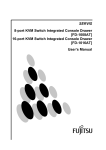

![SERVIS Console Drawer [ FD-1000AT ] User`s Manual](http://vs1.manualzilla.com/store/data/005855835_1-b5ddde4919c279623ac643a1427d1fab-150x150.png)
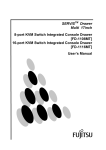
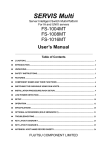

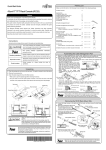




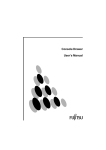
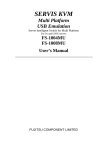
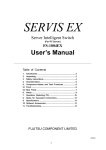

![USER Manual for WiFi edited5[1] - the Naples Free-Net](http://vs1.manualzilla.com/store/data/005874834_1-4f1e4f9158101a49e1c12c3e2f124ebe-150x150.png)

